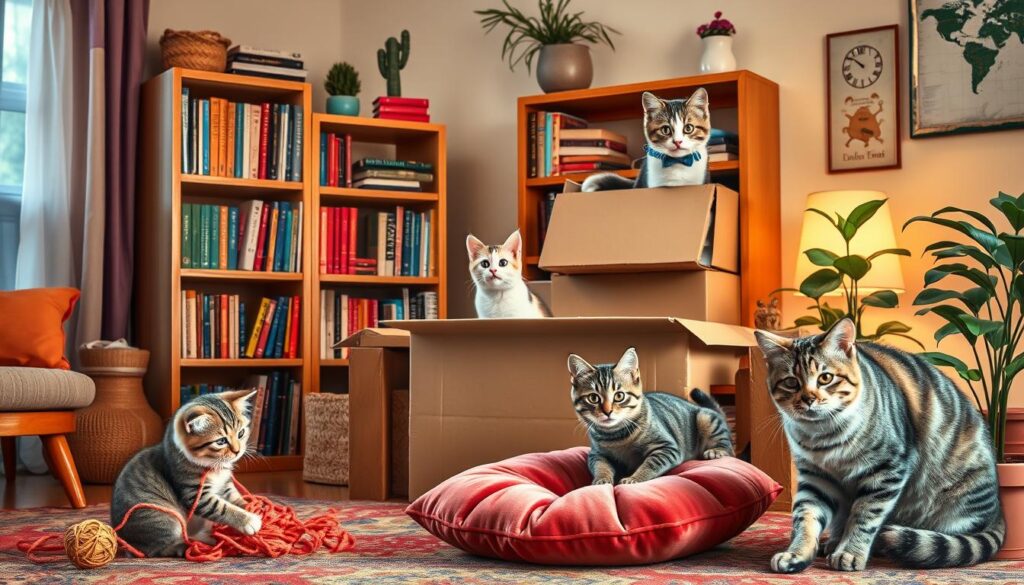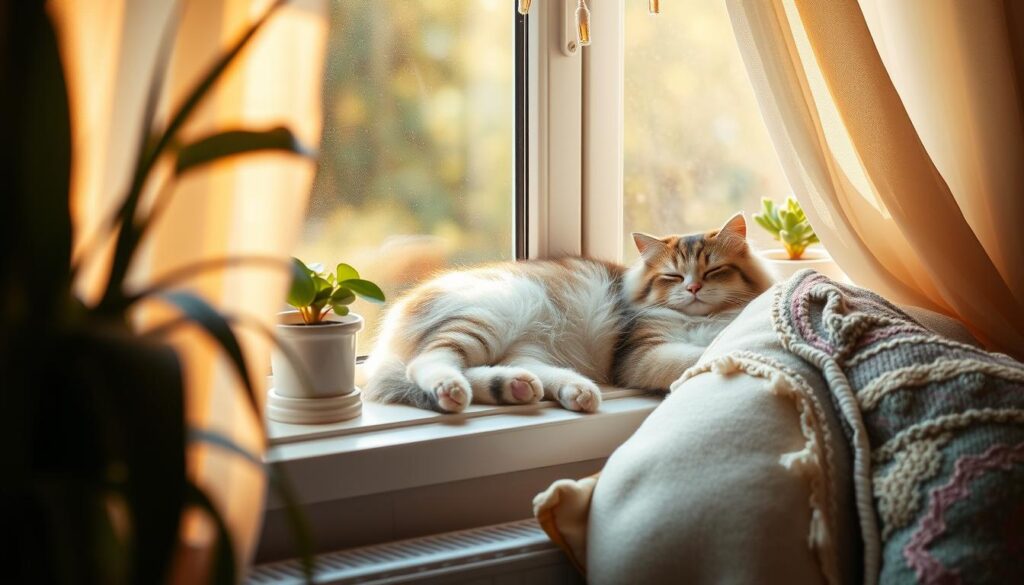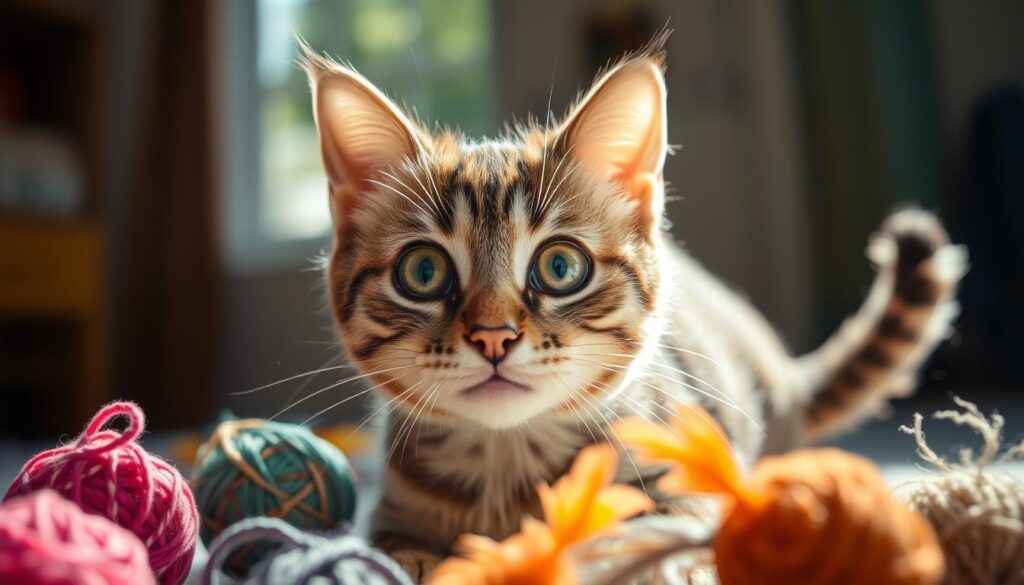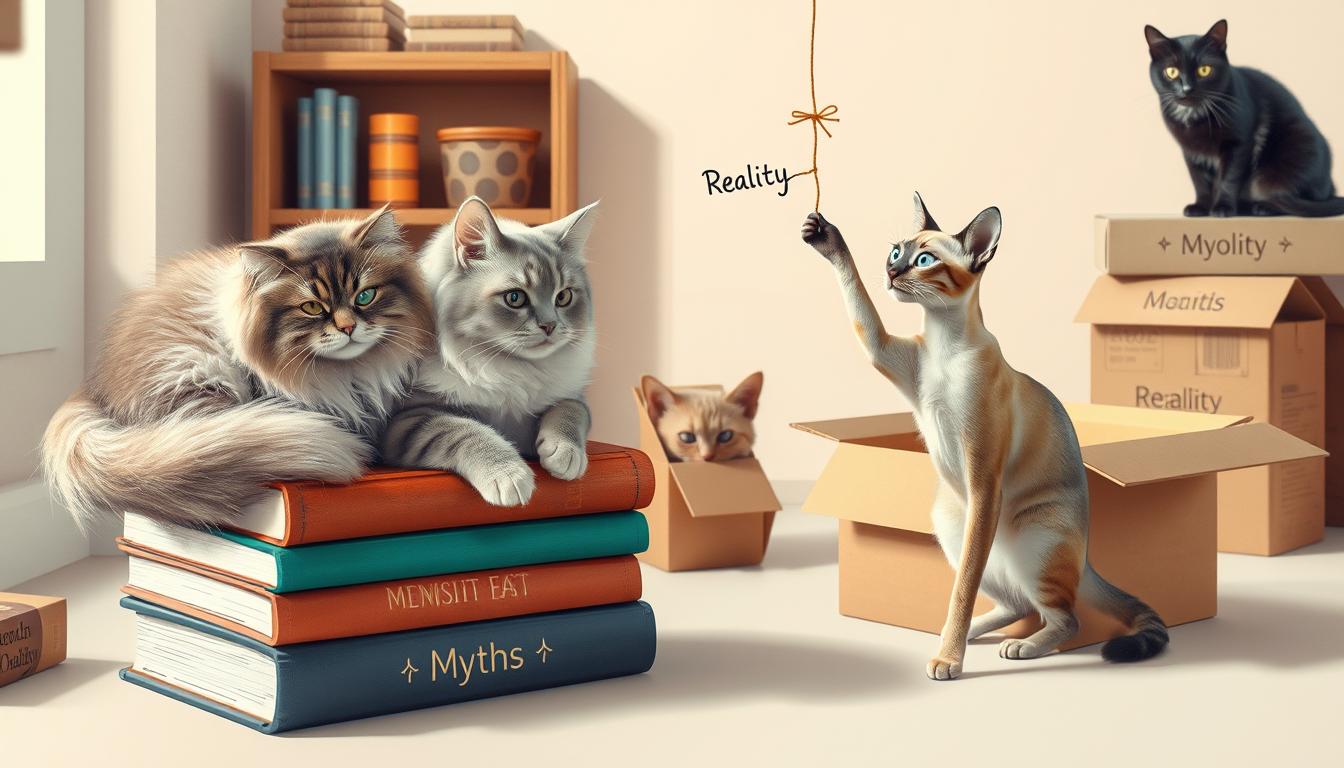Did you know cats don’t always land on their feet when they fall? In fact, falls from high places can hurt them a lot. This is just one of many myths about cats.
People often think cats are cold and don’t need us. But, cats need love and care just like we do. We’ll look into these myths and find out what’s true about cats.
Table of Contents
Common Myths About Cats
Cats are loved by millions worldwide. But, many myths and misconceptions surround them. These myths don’t show the real cats. Let’s look at some common myths and find out what’s true.
Cats Are Always Independent
Cats are seen as independent, but they’re actually very social. They need friends and love. Many cats love their humans and enjoy spending time with them.
How independent a cat is can change. It depends on the cat and its breed.
Felines Are Aloof and Unaffectionate
Many think cats are cold and don’t care about people. But, cats can really connect with their owners. They show love when they feel safe and happy.
Things like breed and personality play a big role. They affect how affectionate a cat can be.
They Can’t Be Trained
It’s believed cats can’t be trained. But, they can learn many things. They might not always want to, but they can with the right approach.
Training cats works best when it fits their natural ways. This makes learning fun for them.
Knowing the truth about cats helps us appreciate them more. It makes our lives with cats better and more loving.

“Cats are the ultimate narcissists. You can tell this because of all the time they spend on personal grooming. Dogs aren’t like this. A dog’s idea of personal grooming is to roll in a dead fish.”
– James Gorman
Dietary Misconceptions
There are many myths about cat care that need to be cleared up. It’s not true that cats can only eat meat. Also, not all dairy is safe for them.
Cats Can’t Survive on a Strictly Carnivorous Diet
Cats need certain nutrients found in meat, like taurine. But they can’t just eat meat all the time. They need a balanced diet from high-quality pet food.
Dairy Products Are Not Safe for All Cats
Cats can have food allergies, including to beef, dairy, and chicken. Some cats might be okay with a little dairy, but it’s best to avoid it. It can upset their stomachs. Taking your cat to the vet regularly is important.
It’s key to understand feline nutrition for our pets’ health. Knowing the myths about cat diets helps us feed them right. This way, they can stay healthy and happy.
Behavior and Personality Myths
Cats are not as simple as we think. They have complex feelings and social needs. Learning the truth about them helps us love them more.
Cats Only Purr When They’re Happy
Purring is not just for happiness. Cats purr when they’re in pain, scared, or want attention. Knowing this helps us care for them better.
They Don’t Need Socialization
Cats are social animals. They need to interact with people and other pets. Without this, they might become aggressive or anxious. Socializing them early makes them happy and friendly.
| Cat Socialization Recommendations | Recommended Alone Time |
|---|---|
| Kittens (under 1 year) | 4 hours or less |
| Adult Cats (1-10 years) | 4-8 hours |
| Senior Cats (over 10 years) | 4 hours or less |
By understanding cats better, we can have a better relationship with them. We can give them the care and attention they need to be happy.
The Myth of Cat Napping
Cats don’t sleep all day because they’re lazy. They have a special sleep pattern that keeps them healthy. Cats can sleep up to 18 hours a day. But, this isn’t just for some breeds.
The time a cat sleeps depends on its instincts and where it lives.
Cats Sleep All Day Because They’re Lazy
People think cats are lazy because they sleep a lot. But, their sleep is very important. Cats are most active at dawn and dusk.
They hunt, explore, and socialize during these times. The rest of the day, they rest and save energy. This is how they survive.
Only Certain Breeds Are Sleepy
Some cat breeds, like Siamese, are more active. But, all cats need a lot of sleep. This is true for all felines, not just some.
Things like age, how active they are, and their environment affect their sleep. But, it’s not true that some breeds sleep more than others. A good home with lots to do helps cats sleep right.

In conclusion, cats don’t sleep all day because they’re lazy. Their sleep is key to their health. Knowing about their sleep helps us take better care of them.
Understanding Cat Communication
Cats are often misunderstood, and their ways of talking are no exception. They don’t just meow to talk to their owners. Cats use many ways to share their thoughts and feelings with humans and other cats.
Cats Meow to Everyone, Not Just Their Owners
Cats meow to get attention, but they also talk to other cats and humans they know. Kittens meow to their moms when they’re hungry or upset. Adult cats meow to ask for food, play, or love from their people.
Hissing Doesn’t Always Mean Anger
Many think hissing means cats are angry. But cats hiss for many reasons, like fear, being uncomfortable, or even playing. A hissing cat might feel scared or too full, trying to say they’re not okay. It’s important to understand what’s happening around them to know why they’re hissing.

By understanding how cats talk, we can have better relationships with them. Watching their sounds, faces, and how they stand can tell us a lot. It helps us get to know their cat behavior and feline truths better.
Feline Health Myths
As devoted pet owners, it’s key to know fact from fiction about cat health and vet care. Indoor cats need regular check-ups to stay healthy. These visits help vets catch issues like obesity and dental disease early.
Indoor Cats Don’t Need Regular Vet Visits
Indoor cats face fewer dangers but still get sick. They need cat care and feline facts to stay well. Skipping vet visits can let problems get worse, hurting your cat’s life quality.
Declawing Is a Standard Procedure
Many think declawing is safe for cats. But, declawing is a big debate with serious side effects. It can cause pain and change how your cat moves. Instead, use scratching posts and trim nails to stop scratching damage.
Learning the truth about cats helps give them the best feline care. This keeps them healthy and happy.
“Regular veterinary check-ups are essential for monitoring pets’ nutritional needs and overall health.”
The Myth of Cat Intelligence
Many people think cats are not very smart. But, the truth is different. Each cat is unique, and their smarts can change a lot.
Some folks believe cats can’t learn tricks. But, cats can learn new things. They just need patience and the right way to teach them.
| Myth | Fact |
|---|---|
| All cat breeds are equally smart. | Feline intelligence varies among different breeds, with some exhibiting higher cognitive abilities than others. |
| Cats can’t learn tricks. | With proper training techniques, cats can be taught a range of tricks and behaviors, showcasing their cognitive capabilities. |
By learning the truth about cats, we can see how amazing they are. Understanding cat behavior and feline truths helps us appreciate them more. It makes our bond with them stronger and more meaningful.
Superstitions Surrounding Cats
Cats have long been the subject of many superstitions and stories. These stories often change how people see and treat cats. From the idea that black cats bring bad luck to the myth of cats stealing babies’ breath, these beliefs have greatly affected how society views cats.
Black Cats and Bad Luck
The idea that black cats are unlucky has lasted for centuries. In some cultures, however, black cats are actually seen as lucky and prosperous. This belief has hurt black cats, making them harder to adopt and leading to more being put down in shelters.
Cats Stealing Babies’ Breath
Many believe cats can take a baby’s breath. This myth makes people keep cats away from babies, even though it’s not true. Cats don’t harm a baby’s breathing, and this fear comes from misinformation.
It’s key to know where these superstitions come from and how they affect cats. By fighting cat misconceptions and sharing feline facts, we can clear up old cat myths. This helps us understand and care for these companion animals better.
“Superstitions are a product of the human mind, not the feline nature. It’s important to separate fact from fiction when it comes to our understanding of cats.”
The Role of Cats in Popular Culture
Cats have a big place in our culture. They grab our attention in movies and online. Their roles in media show what people think about them, both right and wrong.
Movies Accurately Portray Cat Behavior
Hollywood loves to show cats in movies. They make cats seem independent and a bit magical. But, do these movies really show how cats act in real life?
Many movies make cats seem cold and hard to train. This doesn’t always match how cats really are. Cats are more than just their movie roles.
Internet Memes Reflect Real Cat Traits
The internet is full of funny cat pictures and videos. These online jokes often show what cats are really like. They show cats’ love for sleep and play.
These digital jokes are often more true to life than movies. They give us a better look at what makes cats special.
>> Brand New! Cat Language How to Finally Speak Cat! <<

